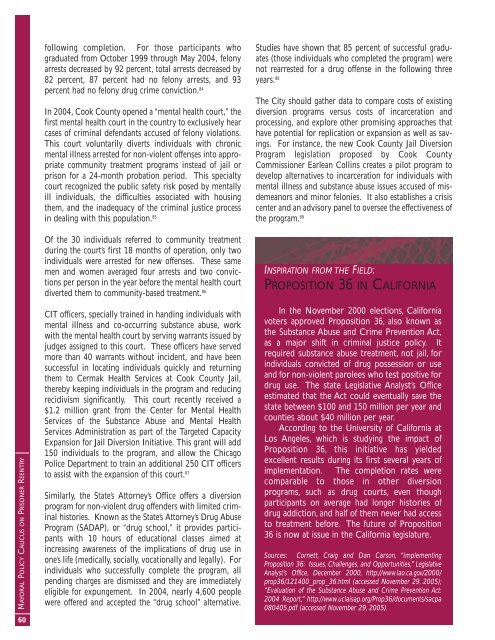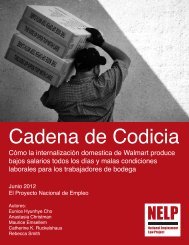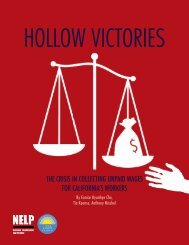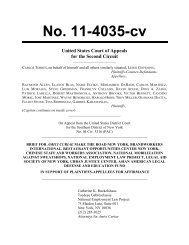Rebuilding Lives. Strengthening Communities.
Rebuilding Lives. Strengthening Communities.
Rebuilding Lives. Strengthening Communities.
You also want an ePaper? Increase the reach of your titles
YUMPU automatically turns print PDFs into web optimized ePapers that Google loves.
MAYORAL POLICY CAUCUS ON PRISONER REENTRY<br />
60<br />
following completion. For those participants who<br />
graduated from October 1999 through May 2004, felony<br />
arrests decreased by 92 percent, total arrests decreased by<br />
82 percent, 87 percent had no felony arrests, and 93<br />
percent had no felony drug crime conviction. 84<br />
In 2004, Cook County opened a “mental health court,” the<br />
first mental health court in the country to exclusively hear<br />
cases of criminal defendants accused of felony violations.<br />
This court voluntarily diverts individuals with chronic<br />
mental illness arrested for non-violent offenses into appropriate<br />
community treatment programs instead of jail or<br />
prison for a 24-month probation period. This specialty<br />
court recognized the public safety risk posed by mentally<br />
ill individuals, the difficulties associated with housing<br />
them, and the inadequacy of the criminal justice process<br />
in dealing with this population. 85<br />
Of the 30 individuals referred to community treatment<br />
during the court’s first 18 months of operation, only two<br />
individuals were arrested for new offenses. These same<br />
men and women averaged four arrests and two convictions<br />
per person in the year before the mental health court<br />
diverted them to community-based treatment. 86<br />
CIT officers, specially trained in handing individuals with<br />
mental illness and co-occurring substance abuse, work<br />
with the mental health court by serving warrants issued by<br />
judges assigned to this court. These officers have served<br />
more than 40 warrants without incident, and have been<br />
successful in locating individuals quickly and returning<br />
them to Cermak Health Services at Cook County Jail,<br />
thereby keeping individuals in the program and reducing<br />
recidivism significantly. This court recently received a<br />
$1.2 million grant from the Center for Mental Health<br />
Services of the Substance Abuse and Mental Health<br />
Services Administration as part of the Targeted Capacity<br />
Expansion for Jail Diversion Initiative. This grant will add<br />
150 individuals to the program, and allow the Chicago<br />
Police Department to train an additional 250 CIT officers<br />
to assist with the expansion of this court. 87<br />
Similarly, the State’s Attorney’s Office offers a diversion<br />
program for non-violent drug offenders with limited criminal<br />
histories. Known as the State’s Attorney’s Drug Abuse<br />
Program (SADAP), or “drug school,” it provides participants<br />
with 10 hours of educational classes aimed at<br />
increasing awareness of the implications of drug use in<br />
one’s life (medically, socially, vocationally and legally). For<br />
individuals who successfully complete the program, all<br />
pending charges are dismissed and they are immediately<br />
eligible for expungement. In 2004, nearly 4,600 people<br />
were offered and accepted the “drug school” alternative.<br />
Studies have shown that 85 percent of successful graduates<br />
(those individuals who completed the program) were<br />
not rearrested for a drug offense in the following three<br />
years. 88<br />
The City should gather data to compare costs of existing<br />
diversion programs versus costs of incarceration and<br />
processing, and explore other promising approaches that<br />
have potential for replication or expansion as well as savings.<br />
For instance, the new Cook County Jail Diversion<br />
Program legislation proposed by Cook County<br />
Commissioner Earlean Collins creates a pilot program to<br />
develop alternatives to incarceration for individuals with<br />
mental illness and substance abuse issues accused of misdemeanors<br />
and minor felonies. It also establishes a crisis<br />
center and an advisory panel to oversee the effectiveness of<br />
the program. 89<br />
INSPIRATION FROM THE FIELD:<br />
PROPOSITION 36 IN CALIFORNIA<br />
In the November 2000 elections, California<br />
voters approved Proposition 36, also known as<br />
the Substance Abuse and Crime Prevention Act,<br />
as a major shift in criminal justice policy. It<br />
required substance abuse treatment, not jail, for<br />
individuals convicted of drug possession or use<br />
and for non-violent parolees who test positive for<br />
drug use. The state Legislative Analyst’s Office<br />
estimated that the Act could eventually save the<br />
state between $100 and 150 million per year and<br />
counties about $40 million per year.<br />
According to the University of California at<br />
Los Angeles, which is studying the impact of<br />
Proposition 36, this initiative has yielded<br />
excellent results during its first several years of<br />
implementation. The completion rates were<br />
comparable to those in other diversion<br />
programs, such as drug courts, even though<br />
participants on average had longer histories of<br />
drug addiction, and half of them never had access<br />
to treatment before. The future of Proposition<br />
36 is now at issue in the California legislature.<br />
Sources: Cornett, Craig and Dan Carson, “Implementing<br />
Proposition 36: Issues, Challenges, and Opportunities,” Legislative<br />
Analyst’s Office, December 2000, http://www.lao.ca.gov/2000/<br />
prop36/121400_prop_36.html (accessed November 29, 2005);<br />
“Evaluation of the Substance Abuse and Crime Prevention Act:<br />
2004 Report,” http://www.uclaisap.org/Prop36/documents/sacpa<br />
080405.pdf (accessed November 29, 2005).
















